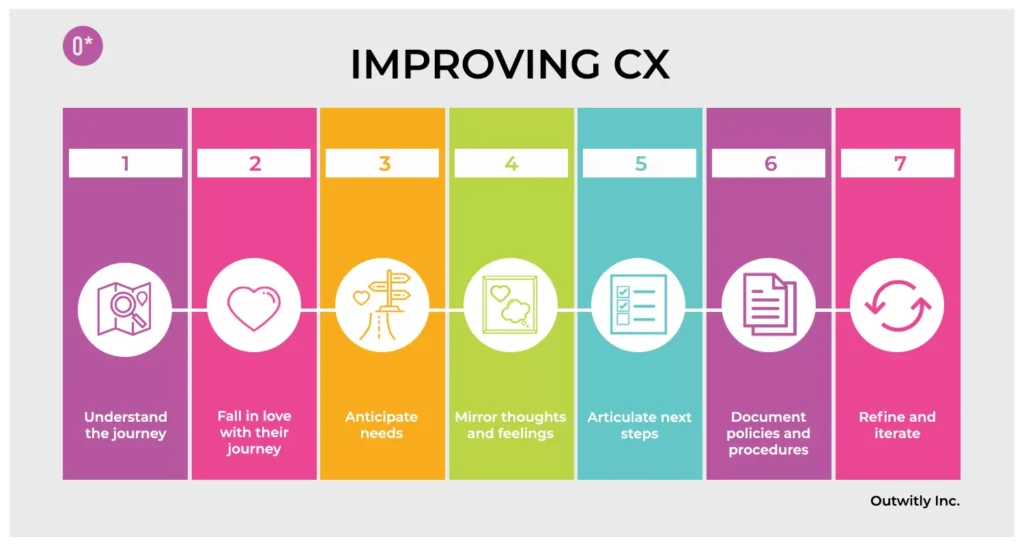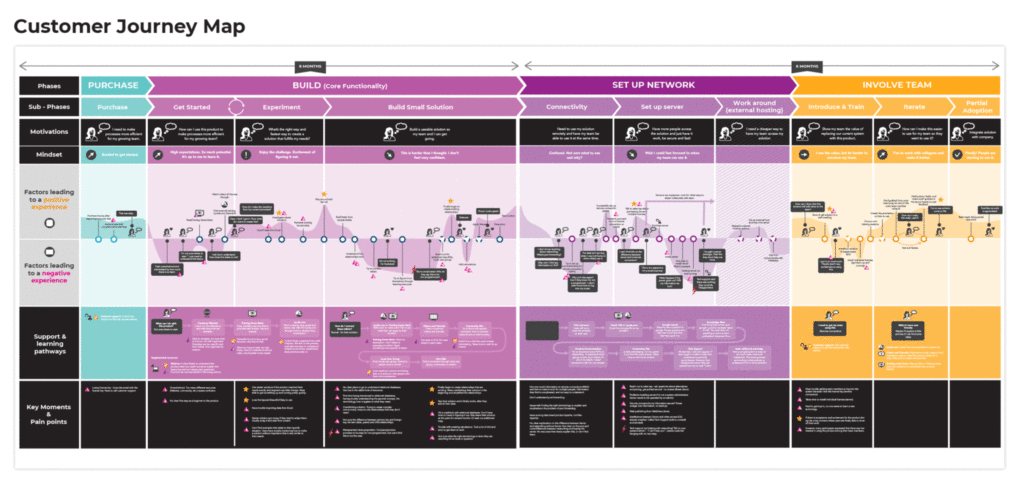The power of exceptional customer experience is undeniable, which is why 80 percent of leaders plan to increase customer service budgets over the next year (ZenDesk). As a consultancy working with organizations on UX design and service design, we aim to improve customer satisfaction and loyalty. However, in many cases, our work stops with design recommendations or with the implementation of a digital service or product. Rarely are we involved in the later stages of execution and delivery of the services we help to design. The reason for this most certainly isn’t because the execution isn’t as important! In fact, there is so much to do on the execution side of a service that is essential to creating a great experience for your customers.
Recently, we turned our “service design” methodology inwards and conducted a full-blown design research project on some of our key internal operations. The results were powerful and are an excellent example of why design and research work should continue past the early phases of the design process.
This blog post will go beyond design recommendations and initial implementation to focus on the execution of great services. We’ll cover seven key steps to improving your customer experience, from the basics of understanding the journey to anticipating needs and seeking feedback to refine CX processes. Let’s dive into it!
Improve Your Customer Experience With These 7 Steps

1. Understand Your User/Customer Journey
Before you can improve an experience, you need to understand what your customers’ current state looks and feels like! The first step to improving your CX is to map the customer journey. This tip may seem simple, but doing the work to research your customers and understand their spoken and unspoken needs, pain points, and motivations is critical. Create a detailed customer journey map to highlight the touchpoints customers encounter, challenges they face, and possible areas of improvement. Our favorite research methods for journey mapping include shadowing customers, in-depth interviews, and diary studies.
Note – when we talk about customer journey maps, we are talking about something other than the typical awareness, consideration, and decision journey you see in marketing. If you’re still not sure what journey mapping is or why it’s important, we’ve written an entire blog series on the topic:
- The Power of Customer Journey Mapping: 101
- How to Research and Build a Customer Journey Map: 201
- Making Your Journey Map Actionable and Creating Change: 301

2. Fall in Love With Your Customer’s Journey
Once you have a deep understanding (based on research, not assumptions!) of your customer’s journey, the next step is to study it. We recommend having your front-line staff study the journey and become intimately familiar with your user or customer’s experience at every turn. For example, your customer support team should know the answers to the following questions like the back of their hand:
- What bumps in the road are customers facing?
- Which parts of their journey are especially delightful?
- Which parts are particularly painful?
- What areas are making or breaking their experience?
It’s one thing to map out your customer’s experience step-by-step; it’s another to have your internal team know and understand the customer journey by heart so they can help them through. When you fall in love with your customer’s journey, you know when to help them before they even have to ask. You know where they will stumble, and you start automatically imagining ways to make those experiences better or more streamlined.
3. Anticipate Customer Needs
After your staff and team members get to know the journey, they’ll be able to see customer pain points. Before your customers have the chance to hit a roadblock, draft an email, or contact support about a question or issue, your team should anticipate what they’ll ask and proactively circumvent questions and issues as early as possible. Being a few steps ahead of your customer will improve their experience tenfold. They’ll think, “Wow, this company is amazing! I was just about to ask that question, and they knew exactly what I needed.” Deeply understanding your customer enough to anticipate their needs is like looking into a crystal ball – see what will happen before it does and prepare them accordingly. It will feel like magic to customers and save your customer support team time and money.
“More than 85% of customers want to experience proactive communication and contact from a business.” – SuperOffice
4. Mirror Thoughts and Feelings
“Mirroring” is a term in psychology that describes the behavior of reflecting an action or phrase to mimic another person’s feelings or activities. Mirroring can occur subconsciously or consciously and is helpful for putting people at ease. It’s often used in sales, but when we talk about mirroring in the world of customer experience, we mean to say that front-life staff, especially support folks, should have very high EQ (emotional intelligence). Team members in these supportive roles should recognize when customers may be coming up to a good or hard part of the experience and be able to reflect the thoughts and feelings of their customers back to them. If something is frustrating (for example, they haven’t received their package in the mail), mirror that feeling back to them and empathize with their situation. Mirroring can occur in many different situations. It can be done 1:1 on a support call, through an email at the exact right moment in their journey, through a chatbot on your website, and many more places throughout the journey.
Similarly, when your customer approaches an exciting part of their journey, mirror that feeling with a quick note of excitement! Think about opening a package delivered to your house with a kindly written thank you note, reflecting how excited you would feel at that moment. The message might display gratitude for your customer’s support and match their happiness. Similarly to the customer experience, mirroring can happen during the employee experience. For example, when you have a new employee onboarding and know they will hit a frustrating IT roadblock, acknowledge their feelings at that moment just as you would your customers. Remember – a little empathy goes a long way!
5. Articulate Their Next Steps
People like to know what’s coming up next – it’s human nature! In the same way that you or I wonder about what’s next on our family vacation, customers want to know what’s next in the process for them when interacting with a service. Think about the game-changing ability to track a package. Seeing that a package has left the distribution center and is on its way reduces customer anxiety (and support call volume) because people know what to expect next. Even though some areas of the journey might not be in a business’ control and may indeed be frustrating for customers, simply knowing that helps. It’s the “not knowing” that can drive your customers crazy.
Consider articulating that an upcoming piece of the journey will test their patience! Telling your customers what challenges they may face in advance eases frustration and anxiety. Wherever possible, provide clarity around what they can expect and prepare them for any roadblocks they may encounter. Use diagrams and visuals to describe the high-level process to them. Bonus points if you can send them helpful tips for when they do meet that challenge (anticipating needs!) Eventually, you may even be able to improve or remove that stumbling block from their journey altogether, but until then, be sure to communicate what’s coming up next!
6. Document Policies and Procedures
Now that you have a research-backed customer journey map, staff are hyper-aware of where customers may stumble, and you’ve created some systems for responding to their needs and setting expectations, it’s important to document all the policies and procedures your company uses to execute the service. Doing this makes good business sense because documented procedures mean you’ve created a repeatable system that can scale and ensures a consistent customer experience with fewer issues falling through the cracks. After establishing these Standard Operating Procedures (SOPs) in great detail, use an integrated project management software to track and assign tasks to your team members. At Outwitly, we love to templatize wherever we can, and tools like Asana and ClickUp allow you to turn your SOPs into a simple list of repeatable tasks. Easy peasy!
7. Refine and Iterate the Process
Once your systems are working well, businesses should continually seek feedback in order to improve their service and processes. This can be done through a Net Promoter Score (NPS) survey, general customer surveys, social media audits, qualitative research, or hosting post-mortems internally. As you test your service and receive feedback, be sure to refine and iterate the process, update your SOPs and look for ways to improve the journey.
We hope this post helped to articulate the importance of actively working to improve your user and customer experience. These seven tangible tips will take any CX to the next level!





